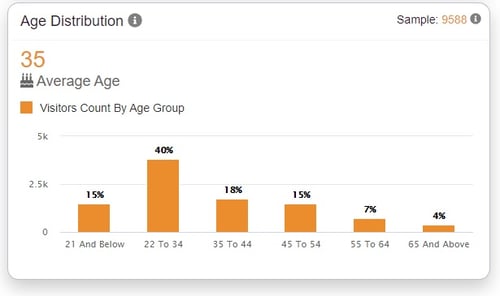Customer Segmentation to Power Up Your Restaurant Marketing
In today’s post-COVID, hyper-competitive restaurant industry, restaurateurs and marketers are always searching for an ef...
Read full articleA recent study conducted by The NPD Group, ranked the 8th largest market research company in the world by the AMA Gold Top 50 report, found that Generation Z may soon be giving a large boost to restaurant industry traffic.
In a recent RestaurantHospitality.com article, Gen Z was described as being, “...tech-savvy and socially conscious — and love to dine out. In fact, these consumers, born from 1995 to 2012, made 11 billion restaurant visits to restaurants in the year ended July 2019, and now represents 24 percent of total foodservice traffic. They are also the strongest users of fast-casual restaurants.”
At the same time, Millennials and Baby Boomers are slowly reducing their number of visits to restaurants, and this trend is expected to continue.
Why Generational Segmentation Is Crucial
This poses a major issue for restaurant marketing professionals, namely the fact that one message or incentive won’t resonate with all of their customers cross-generationally. With the divergence of each generation in terms of dining preferences, it only makes sense that each of these generational personas would engage better with messages aimed directly at those preferences.

For instance, since the Baby Boomers are visiting restaurants less and less, it would make sense to send them a worthwhile incentive to get them back through your doors. On the other hand, the Gen Z population is visiting more and more, so sending them an incentive would only drive up marketing costs.
Likewise, the tone and scope of your message would be different when marketing to older Baby Boomers versus the younger Gen Z crowd.
Without the benefit of having actual customer data to use for creating marketing campaigns, marketers are left to base campaigns and messages more on their personal opinion. In this situation, effective marketing becomes extremely difficult to manage, measure, and keep profitable.
The issue then becomes having a way to collect customer data in an effective, affordable, non-obtrusive, and secure manner.
WiFi analytics solves this problem.
WiFi Analytics Is The Best Solution For Restaurant Customer Data Collection
Implementing a top-quality WiFi marketing and analytics platform like Bloom Intelligence allows restaurant owners and operators to collect accurate customer data using their guest WiFi access point. Even if a customer doesn’t log into the WiFi, their mobile device will be detected, and the platform will log and track that device based on its unique ID.
This provides powerful and comprehensive customer behavior data, also known as location analytics. It is considered “anonymous” data because it is not yet tied to a specific person – only a device. This type of data includes:
When a customer logs into the WiFi access point, they are taken to a WiFi landing page, also known as a captive portal. When they enter their name and email address to gain internet access, the platform will then tie all of the previously collected device data to a person, along with their contact information.
A customer profile is created for the guest and all previous and future behavior data will be shown there. If they log in using a social media platform, then any public demographic data will also be placed into the customer profile, such as age and gender.
Bloom will then begin progressively profiling the customer. This means that any subsequent attempts to log into WiFi will result in a request for an additional piece of information, such as phone number, age, gender, or postal code. Over time, a comprehensive, detailed profile will be created.
Segmenting WiFi-Collected Customer Data
 Bloom users have passively built enormous databases of customer profiles. Overall average age of customers can be easily seen on the Bloom dashboard. This will give you a great idea of where to place the most focus as you get started. And it will act as a measurement tool moving forward.
Bloom users have passively built enormous databases of customer profiles. Overall average age of customers can be easily seen on the Bloom dashboard. This will give you a great idea of where to place the most focus as you get started. And it will act as a measurement tool moving forward.
What’s more, the customer database can be easily sorted and filtered by certain demographics, including age, and saved for use later. This means that users can create various customer lists and develop separate marketing campaigns for each of them.
Given the data found in the NPD Group study, restaurant marketers will need this ability in order to stay relevant to their customers, stay ahead of the competition and keep their seats full. It allows them to market efficiently to each generation separately, sending more targeted messaging that more customers will engage with.
According to a study from Mailchimp, marketing email recipients are 75% more likely to click on emails from segmented campaigns than non-segmented campaigns. And an article from CMO.com stated that targeted promotions are, on average, almost twice as effective as non-targeted ones. Mailchimp also noted that email open rates are 14.31% higher in segmented campaigns.
Customer segmentation is just one of the many features and growth tools available with Bloom Intelligence. Take a look at our white papers and case studies to see how WiFi marketing and analytics can help your business grow.
Click here or call us at 727-877-8181 for a free, no-obligation demo of the Bloom Intelligence platform.
Related Topics
Guides
In today’s post-COVID, hyper-competitive restaurant industry, restaurateurs and marketers are always searching for an ef...
Read full articleRestaurant email marketing is a fundamental component of successful restaurant marketing best practices. When paired wit...
Read full articleEmail marketing has always been one of the most effective and widely used marketing strategies. And it only appears to b...
Read full articleNever miss a post! We'll keep you up-to-date on the latest restaurant and retail WiFi marketing information.

.svg)
We would love to hear from you! If you have any questions, comments or ideas about our blog, drop us a line and let us know.
Or call us at 727-877-8181.